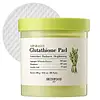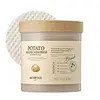What's inside
What's inside
 Key Ingredients
Key Ingredients

 Benefits
Benefits

 Concerns
Concerns

 Ingredients Side-by-side
Ingredients Side-by-side

Water
Skin ConditioningMethyl Gluceth-20
HumectantMethylpropanediol
SolventNiacinamide
Smoothing1,2-Hexanediol
Skin ConditioningPolyglycerin-3
HumectantMethyl Gluceth-10
EmulsifyingGlycereth-26
HumectantGluconolactone
Skin ConditioningEthylhexylglycerin
Skin ConditioningAsparagus Officinalis Extract
Skin ConditioningAdenosine
Skin ConditioningDisodium EDTA
Panthenol
Skin ConditioningGlutathione
Dipotassium Glycyrrhizate
HumectantAllantoin
Skin ConditioningCitrus Aurantium Dulcis Flower Oil
AstringentLitsea Cubeba Fruit Oil
MaskingCitrus Paradisi Peel Oil
MaskingCitrus Aurantium Bergamia Fruit Oil
MaskingGlucose
HumectantMentha Viridis Leaf Oil
AstringentBarosma Betulina Leaf Extract
PerfumingAscorbic Acid
AntioxidantTromethamine
BufferingTocopherol
AntioxidantSodium Hyaluronate
HumectantFerulic Acid
AntimicrobialBisabolol
MaskingGlycerin
HumectantBeta-Glucan
Skin ConditioningHesperidin
EmollientErgothioneine
AntioxidantLimonene
PerfumingLinalool
PerfumingCitral
PerfumingWater, Methyl Gluceth-20, Methylpropanediol, Niacinamide, 1,2-Hexanediol, Polyglycerin-3, Methyl Gluceth-10, Glycereth-26, Gluconolactone, Ethylhexylglycerin, Asparagus Officinalis Extract, Adenosine, Disodium EDTA, Panthenol, Glutathione, Dipotassium Glycyrrhizate, Allantoin, Citrus Aurantium Dulcis Flower Oil, Litsea Cubeba Fruit Oil, Citrus Paradisi Peel Oil, Citrus Aurantium Bergamia Fruit Oil, Glucose, Mentha Viridis Leaf Oil, Barosma Betulina Leaf Extract, Ascorbic Acid, Tromethamine, Tocopherol, Sodium Hyaluronate, Ferulic Acid, Bisabolol, Glycerin, Beta-Glucan, Hesperidin, Ergothioneine, Limonene, Linalool, Citral
Water
Skin ConditioningButylene Glycol
HumectantGlycerin
HumectantNiacinamide
Smoothing1,2-Hexanediol
Skin ConditioningHydroxyacetophenone
AntioxidantPPG-13-Decyltetradeceth-24
EmulsifyingBetaine
HumectantAllantoin
Skin ConditioningSodium Citrate
BufferingDipotassium Glycyrrhizate
HumectantSolanum Tuberosum Pulp Extract
SmoothingBeta-Glucan
Skin ConditioningCitric Acid
BufferingSodium Phytate
Sodium Hyaluronate
HumectantAmmonium Acryloyldimethyltaurate/Vp Copolymer
Helianthus Annuus Seed Oil
EmollientMadecassoside
AntioxidantSodium Ascorbyl Phosphate
AntioxidantGlyceryl Acrylate/Acrylic Acid Copolymer
HumectantPogostemon Cablin Leaf Oil
MaskingDipropylene Glycol
HumectantSclerotium Gum
Emulsion StabilisingPvm/Ma Copolymer
Emulsion StabilisingSalvia Officinalis Oil
MaskingHydrogenated Lecithin
EmulsifyingPolyglyceryl-10 Laurate
Skin ConditioningCentella Asiatica Extract
CleansingAsiaticoside
AntioxidantMadecassic Acid
Skin ConditioningAsiatic Acid
Skin ConditioningLavandula Angustifolia Oil
MaskingCaffeine
Skin ConditioningSalvia Sclarea Oil
MaskingRosmarinus Officinalis Leaf Oil
MaskingCaprylyl Glycol
EmollientWater, Butylene Glycol, Glycerin, Niacinamide, 1,2-Hexanediol, Hydroxyacetophenone, PPG-13-Decyltetradeceth-24, Betaine, Allantoin, Sodium Citrate, Dipotassium Glycyrrhizate, Solanum Tuberosum Pulp Extract, Beta-Glucan, Citric Acid, Sodium Phytate, Sodium Hyaluronate, Ammonium Acryloyldimethyltaurate/Vp Copolymer, Helianthus Annuus Seed Oil, Madecassoside, Sodium Ascorbyl Phosphate, Glyceryl Acrylate/Acrylic Acid Copolymer, Pogostemon Cablin Leaf Oil, Dipropylene Glycol, Sclerotium Gum, Pvm/Ma Copolymer, Salvia Officinalis Oil, Hydrogenated Lecithin, Polyglyceryl-10 Laurate, Centella Asiatica Extract, Asiaticoside, Madecassic Acid, Asiatic Acid, Lavandula Angustifolia Oil, Caffeine, Salvia Sclarea Oil, Rosmarinus Officinalis Leaf Oil, Caprylyl Glycol
 Reviews
Reviews

Ingredients Explained
These ingredients are found in both products.
Ingredients higher up in an ingredient list are typically present in a larger amount.
1,2-Hexanediol is a synthetic liquid and another multi-functional powerhouse.
It is a:
- Humectant, drawing moisture into the skin
- Emollient, helping to soften skin
- Solvent, dispersing and stabilizing formulas
- Preservative booster, enhancing the antimicrobial activity of other preservatives
Allantoin is a soothing ingredient known for its protective and moisturizingg properties. Because of this, it is often added to products with strong active ingredients.
Studies show higher concentrations of this ingredient can promote wound healing.
Though it can be derived from the comfrey plant, allantoin is produced synthetically for cosmetic products to ensure purity.
Learn more about AllantoinBeta-Glucan is a polysaccharide. It can be derived from the cell walls of seaweed, oats, yeast, and fungi. It hydrates the skin and helps boost your skin's natural barrier.
As an antioxidant, beta-glucan helps fight free-radicals. Free-radicals are molecules that may damage your skin cells, such as pollution.
Studies show this ingredient may be an effective wrinkle reducer as it can deeply penetrate into skin. It has also been show to help with wound healing.
Learn more about Beta-GlucanDipotassium Glycyrrhizate comes from licorice root.
Extracts of licorice have demonstrated to have antibacterial, anti‐inflammatory, antiviral, antioxidant properties.
One component, glabridin, has extra potent antioxidant and soothing properties. It has also been found to block pigmentation from UVB rays in guinea pigs.
Licorice Root also contains a flavonoid. Flavonoids are a natural substance from in plants. Flavonoids also have antioxidant properties.
Another component, glycyrrhizin, has been found to have anti-inflammatory and antimicrobial benefits. This may make licorice root extract effective at treating acne. However, more research is needed to support this.
Liquiritin is one of the flavone compounds found in licorice. It has been found to help lighten skin by preventing tyrosinase from reacting with tyrosine. When the two react, protein is converted to melanin. Melanin is the substance in your body that gives your features pigmentation.
Licorice root is native to Southern Europe and Asia. It has been used in traditional Chinese medicine to help with respiratory issues.
Learn more about Dipotassium GlycyrrhizateGlycerin is already naturally found in your skin. It helps moisturize and protect your skin.
A study from 2016 found glycerin to be more effective as a humectant than AHAs and hyaluronic acid.
As a humectant, it helps the skin stay hydrated by pulling moisture to your skin. The low molecular weight of glycerin allows it to pull moisture into the deeper layers of your skin.
Hydrated skin improves your skin barrier; Your skin barrier helps protect against irritants and bacteria.
Glycerin has also been found to have antimicrobial and antiviral properties. Due to these properties, glycerin is often used in wound and burn treatments.
In cosmetics, glycerin is usually derived from plants such as soybean or palm. However, it can also be sourced from animals, such as tallow or animal fat.
This ingredient is organic, colorless, odorless, and non-toxic.
Glycerin is the name for this ingredient in American English. British English uses Glycerol/Glycerine.
Learn more about GlycerinNiacinamide is a multitasking form of vitamin B3 that strengthens the skin barrier, reduces pores and dark spots, regulates oil, and improves signs of aging.
And the best part? It's gentle and well-tolerated by most skin types, including sensitive and reactive skin.
You might have heard of "niacin flush", or the reddening of skin that causes itchiness. Niacinamide has not been found to cause this.
In very rare cases, some individuals may not be able to tolerate niacinamide at all or experience an allergic reaction to it.
If you are experiencing flaking, irritation, and dryness with this ingredient, be sure to double check all your products as this ingredient can be found in all categories of skincare.
When incorporating niacinamide into your routine, look out for concentration amounts. Typically, 5% niacinamide provides benefits such as fading dark spots. However, if you have sensitive skin, it is better to begin with a smaller concentration.
When you apply niacinamide to your skin, your body converts it into nicotinamide adenine dinucleotide (NAD). NAD is an essential coenzyme that is already found in your cells as "fuel" and powers countless biological processes.
In your skin, NAD helps repair cell damage, produce new healthy cells, support collagen production, strengthen the skin barrier, and fight environmental stressors (like UV and pollution).
Our natural NAD levels start to decline with age, leading to slower skin repair, visible aging, and a weaker skin barrier. By providing your skin niacinamide, you're recharging your skin's NAD levels. This leads to stronger, healthier, and younger looking skin.
Another name for vitamin B3 is nicotinamide. This vitamin is water-soluble and our bodies don't store it. We obtain Vitamin B3 from either food or skincare. Meat, fish, wheat, yeast, and leafy greens contain vitamin B3.
The type of niacinamide used in skincare is synthetically created.
Learn more about NiacinamideSodium Hyaluronate is hyaluronic acid's salt form. It is commonly derived from the sodium salt of hyaluronic acid.
Like hyaluronic acid, it is great at holding water and acts as a humectant. This makes it a great skin hydrating ingredient.
Sodium Hyaluronate is naturally occurring in our bodies and is mostly found in eye fluid and joints.
These are some other common types of Hyaluronic Acid:
Learn more about Sodium HyaluronateWater. It's the most common cosmetic ingredient of all. You'll usually see it at the top of ingredient lists, meaning that it makes up the largest part of the product.
So why is it so popular? Water most often acts as a solvent - this means that it helps dissolve other ingredients into the formulation.
You'll also recognize water as that liquid we all need to stay alive. If you see this, drink a glass of water. Stay hydrated!
Learn more about Water